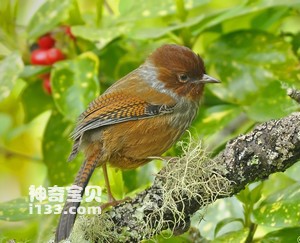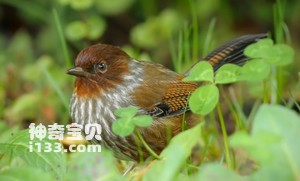The song of the Taiwan spotted-winged babbler (Actinodura morrisoniana) sounds like "Jiao, Jiao", soft and delicate, so the Buyi aborigines of Taiwan call it "Jiao Jiao". Because its wings have beautiful and neat black and maroon stripes arranged alternately, its English name means "patterned-winged thrush"; and because its head is maroon, it is different from other spotted-winged babblers, so it is also called chestnut-headed babbler. This cute and petite bird is only distributed in Taiwan, my country, and is a unique species of Chinese birds.

In January 1906, the British explorer and professional collector Gufiero first discovered the Taiwanese spotted-winged babbler in the Yushan Mountains of Taiwan at an altitude of 2,440 meters. After the British ornithologist Grant identified it, he published it as a new species in the "British Ornithological Bulletin" that year. "This striking new species needs no comparison with any known species because its plumage is so distinctive," Grant wrote.
There are 7 species in the genus Spot-winged Babbler, and Taiwan Spot-winged Babbler is the latest one to be discovered by humans. Except for Taiwan Spot-winged Babbler, which is only distributed in Taiwan, my country, the other six species of this genus are distributed from the foothills of the Himalayas to the Indochina Peninsula. This shows the biogeographical correlation between Taiwan and the Himalayas. From the appearance point of view, the main characteristics of the Taiwan Spotted Babbler are that the head and throat are chestnut brown, and the back neck and abdomen are grayish white with dark brown stripes. The feather colors are very different from the other six species of the Spotted Babbler.
The Taiwanese spotted-winged babbler does not have a loud singing voice, nor does it have beautiful and bright feather colors, but it sings softly and has olive-brown feathers of varying shades all over its body. Compared with other thrushes living in Taiwan, the Taiwanese spotted-winged babbler appears low-key and steady, and its soft calls are often ignored or mistaken for the calls of other animals. Its simple feather color is very close to the color of its branches, making it very concealable. When they fly in the mountains or move among the branches of trees, they are not easy to be spotted even at close distances from people, so some people call them "ninja birds."

Taiwanese spotted-winged babblers are distributed in mid- and high-altitude mountainous areas, inhabiting alpine broad-leaved forests and coniferous and broad-leaved mixed forests at an altitude of 1,400-3,000 meters. They usually move in single-species groups, and small groups of five or six birds are common. In the middle and upper woods, it does not fly long distances, but a single Taiwanese Spotted Babbler has been seen mixed in with a group of White-eared Babblers (Heterophasia aurcularis). Generally speaking, group activities help Taiwanese spotted-winged babblers to alert natural enemies and exchange foraging information, thereby improving foraging efficiency.
The Taiwanese spotted-winged babbler has short round wings and slender but strong claws, which can crawl on tree trunks. They can dexterously hang upside down on twigs or peck in cracks in the bark of trees. Occasionally they fly to the grass at the edge of the forest and peck at arthropods on the surface of the branches of trees or shrubs. According to the research results of Chen Dekang in 1994, among the 229 foraging records, 90% were arthropods that pecked on the epidermis of branches, 1% were arthropods that pecked on pages, and 9% were fruit-eating, such as mountain cherry blossoms, alpine roses, and Elaeagnus And the fruit of Yushan false pear. Xu Haojie's 2002 research results showed that 36% of the foraging behavior of Taiwanese spotted-winged babblers occurred in the middle and upper layers of the canopy, 50% occurred in the lower layer of the canopy, and the shrub layer and herb layer each accounted for 7%.
The Taiwan spotted-winged babbler shows an obvious single-species grouping phenomenon. This may be because they mainly feed on arthropods on the bark surface, and their resource utilization is very different from most birds that feed on foliar arthropods. The Taiwanese spotted-winged babbler cannot join other bird flocks to benefit from feeding together. It is also difficult for other birds to join the Taiwanese spotted-winged babbler group and cannot enjoy the latter's hunting pleasure.
Since the mid-alpine and alpine forests in Taiwan, my country, have been extensively logged, the habitat of the Taiwanese spotted-winged babbler has been reduced, and the current population is small. But they are not hunted, so their survival is not yet in danger. If afforestation in mid-mountain and high mountains can be successful, the population of Taiwan's spotted-winged babbler will also increase over time.
animal tags:
We created this article in conjunction with AI technology, then made sure it was fact-checked and edited by a Animals Top editor.